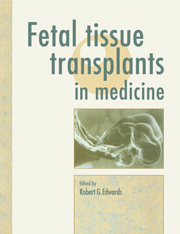Book contents
- Frontmatter
- Contents
- List of contributors
- Preface
- 1 Differentiation and transplantation of embryonic cells in mammals
- 2 Organogenesis and central nervous system development
- 3 Experimental human hematopoiesis in immunodeficient SCID mice engrafted with fetal blood-forming organs
- 4 Ontogeny of human T- and B-cell immunity
- 5 The procurement of human fetal tissues for clinical transplantation. Practice and problems
- 6 Transplantation of fetal haemopoietic and lymphopoietic cells in humans, with special reference to in utero transplantation
- 7 The biology of fetal brain tissue grafts: from mouse to man
- 8 Clinical results of transplanting fetal pancreas
- 9 The suitability of fetal and infantile donors for corneal transplantation
- 10 Transplantation of ovaries and testes
- 11 Cell grafting and gene therapy in metabolic diseases
- 12 The low temperature preservation of fetal cells
- 13 Law and ethics of transplanting fetal tissue
- Appendix: Code of practice on the use of fetuses and fetal material in research and treatment
- Brief bibliography on various aspects of transplanting fetal 337 tissue
- Index
9 - The suitability of fetal and infantile donors for corneal transplantation
- Frontmatter
- Contents
- List of contributors
- Preface
- 1 Differentiation and transplantation of embryonic cells in mammals
- 2 Organogenesis and central nervous system development
- 3 Experimental human hematopoiesis in immunodeficient SCID mice engrafted with fetal blood-forming organs
- 4 Ontogeny of human T- and B-cell immunity
- 5 The procurement of human fetal tissues for clinical transplantation. Practice and problems
- 6 Transplantation of fetal haemopoietic and lymphopoietic cells in humans, with special reference to in utero transplantation
- 7 The biology of fetal brain tissue grafts: from mouse to man
- 8 Clinical results of transplanting fetal pancreas
- 9 The suitability of fetal and infantile donors for corneal transplantation
- 10 Transplantation of ovaries and testes
- 11 Cell grafting and gene therapy in metabolic diseases
- 12 The low temperature preservation of fetal cells
- 13 Law and ethics of transplanting fetal tissue
- Appendix: Code of practice on the use of fetuses and fetal material in research and treatment
- Brief bibliography on various aspects of transplanting fetal 337 tissue
- Index
Summary
THE NORMAL CORNEA is clear and avascular. An opaque cornea interferes with good visual acuity and such patients are candidates for a corneal transplant. Corneal transplantation is the replacement of the central 7 to 8 mm of the diseased organ. The clarity of the graft is used as the parameter for defining graft survival. However, a crystal-clear cornea with an uncorrectable refractive error does not constitute a successful transplant, since visual acuity is not restored. It is the challenge for the ophthalmic surgeon to achieve a clear cornea with curvature that is as close as possible to normal.
Factors affecting the success of corneal transplantation
Endothelial cell density
Numerous factors affect the success of corneal transplantation: i.e. selection and storage of donor corneas, surgical techniques and postoperative therapy. The importance of good donor tissue has been appreciated from the very beginning of corneal surgery. As early as 1906, Zirm stated in his rules for grafting: ‘use a human donor cornea, which should be young and healthy’ (Zirm, 1906). Corneal surgeons have traditionally preferred young donor corneas because of their high endothelial cell density.
Figures 9.1 to 9.4 show the endothelial cell densities in four donor corneas of different ages: 5400, 3500, 2800 and 1200 cells/mm2 at the age of 2 months, 2 years, 20 years and 79 years respectively. There is no regeneration of endothelial cells and the importance of the number and viability of the endothelial cells in maintaining corneal clarity is generally accepted. The high endothelial cell density in corneas of young donors provides a greater buffer against perioperative cell loss and consequently leads to better graft survival. However, the Medical Standards of the Eye Bank Association of America state that the lower age limit for donor corneal tissue is full term birth. A majority of the American Eye Banks and corneal surgeons accepts tissue from donors as young as 6 months old. For many European corneal surgeons the lower limit for acceptance is one year. Beveridge even maintained in 1972 that 'eyes of young children (under five years of age) are unsuitable, because of steep corneal curvature and lack of rigidity (Beveridge, 1972).
- Type
- Chapter
- Information
- Fetal Tissue Transplants in Medicine , pp. 239 - 252Publisher: Cambridge University PressPrint publication year: 1992



